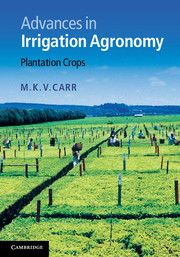11 - Synthesis
Published online by Cambridge University Press: 05 May 2012
Summary
A diverse range of crops has been covered in the preceding chapters, embracing a wide range of products, all united by the common collective title of plantation crops. An attempt is now made to synthesise the findings reported for each crop, despite the difficulties in making direct comparisons, to review the reporting of research findings, and finally to draw some collective conclusions in order to identify a way forward.
Crop comparisons
Summaries of the main findings from the review process are presented for ease of comparison in Tables 11.1 (origins and centres of production), 11.2 (stages of crop development), 11.3 (plant water relations) and 11.4 (water productivity) for each crop.
Origins and centres of production
In nearly all cases the centres of production of a crop are well away from its centre of origin or diversity (Table 11.1). Tea and coconuts are perhaps exceptional in that they are examples of crops that are still grown in quantity in areas close to their origin, although both, like others, continue to spread around the world. Most plantation crops have until relatively recently been associated with large estates but, in nearly all the examples described here, smallholders now dominate in global terms, the exceptions probably being tea and sugar cane. But that generalisation does not hold for individual countries, where the balance between the two main production systems is one of continuing change. In terms of the total harvested area of each crop, sugar cane is the largest (22.7 million ha) followed by oil palm (14.7 million ha). The smallest in area is sisal (0.4 million ha), a crop in decline, followed by tea (3 million ha, but expanding). The world total for all nine crops covered here is about 84 million ha, but the reliability of some of these area estimates is open to question. To put these figures into context there are, for example, about 225 million ha of wheat, 161 million ha of rice and 159 million ha of maize (grain) (FAO, 2011b).
- Type
- Chapter
- Information
- Advances in Irrigation AgronomyPlantation Crops, pp. 275 - 293Publisher: Cambridge University PressPrint publication year: 2012

